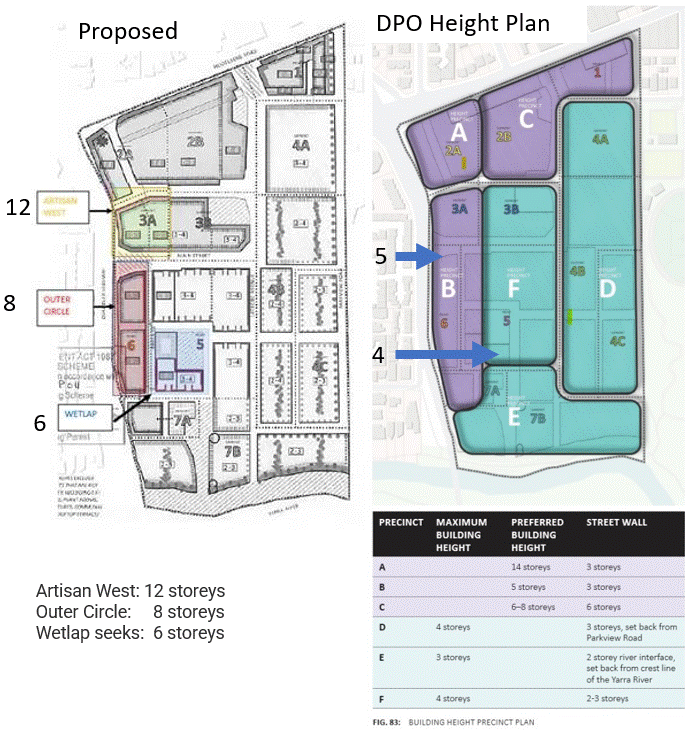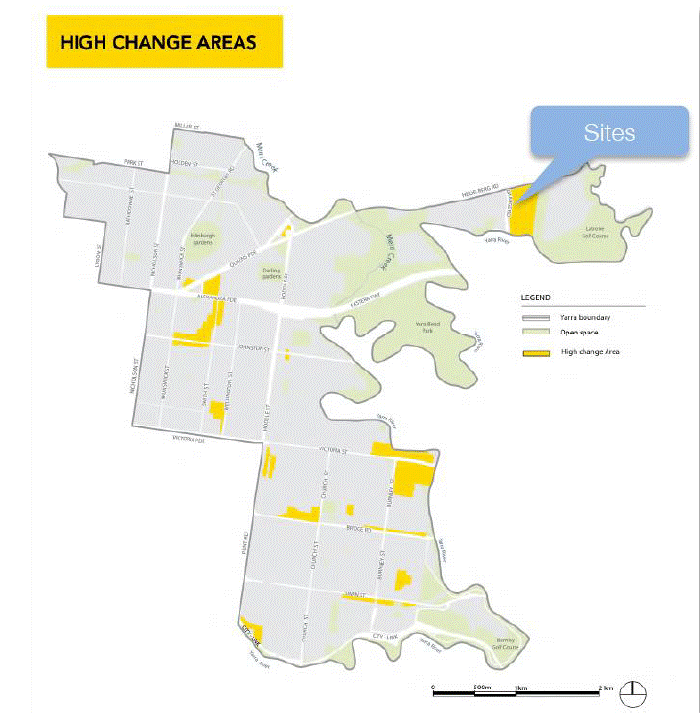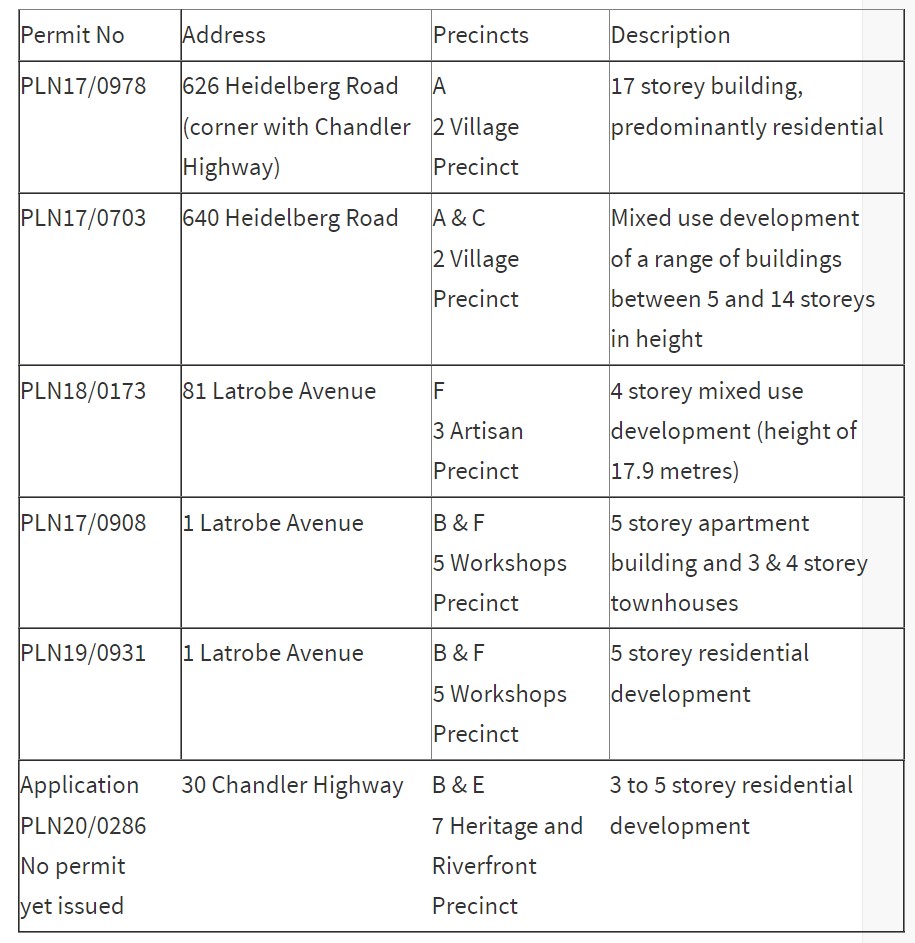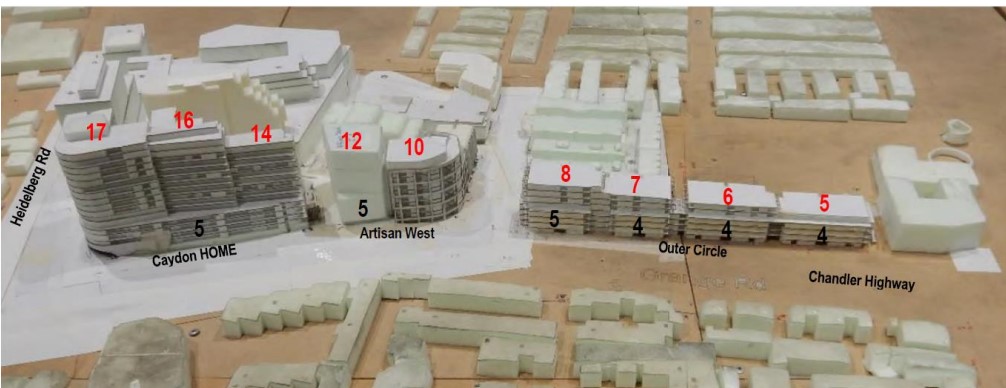The VCAT decision on Glenville’s application to exceed the DPO building heights has been published publicly.
This post is going to give you a quick overview of the judgements and why they happened, but the full text is available here:

Links to VCAT Ref P1815/2020 & P1816/2020
8 main decisions were made by the Panel
Decision 1 – Todd Perry, representing the community group Alphington Fairfield Appropriate Development Association (AFADA) was refused permission to join the application. Participation was refused on the basis of “natural justice and procedural fairness” because a written submission hadn’t been circulated before the meeting, while also acknowledging that nearby residents had, until that late stage, believed application was not permitted. Todd is also an APMAG committee member, and an experienced and tireless representative for community interests, but not a resident of Yarra Bend.
Then some administrative issues were resolved:
- Decision 2 & 6 – The permit was amended to update the addresses – changing lot numbers to street numbers
- Decisions 3 & 7 – the applications were amended to substitute some plan drawings. APMAG will work to get a more thorough summary of the changes, but the first impression is that the changes are minor
- Decisions 4 & 8 – previous authority decisions were set aside. ie VCAT has the authority to over rule other decision
THEN once all that was out of the way, VCAT decided
- Decisions 5 & 9 – The permits for both the Artisan West & Outer Circle buildings were granted, including permissions to (further) reduce the standard car parking requirements in both buildings

When Yarra Council was making their case, their reasons to refuse the permit were:
- concerns with the overall height and scale of both developments,
- the separation between buildings,
- the levels of amenity and solar access to communal and public areas, and
- the room depth of some apartments.
When VCAT was making their decision, their considerations were:
- Are the proposals an appropriate built form response to the context and the Development Plan?
- Will there be any unreasonable off-site amenity impacts?
- Is an appropriate level of internal amenity achieved?
- Does the proposals appropriately provide for car parking and traffic movements?
Alphington designated an area where ‘the highest levels of growth’ are encouraged
VCAT decided tall dense buildings were appropriate because the Yarra Panning Scheme identifies the Paper Mill site as a ‘High Change’ area, with ‘the highest levels’ of growth and regeneration encouraged & expected.

The Panel recommended the ‘high change’ category be applied, and outlined the policies that come with it – such as bigger blocks and denser housing.
The panel noted the prior DPO and its discussion of heights, as well as the importance of local character, the river, park and infrastructure, and noted the range of other council submissions in the area.

The panel judgement goes on to consider aspects of overshadowing, access and the way buildings gradually change height along the Chandler Highway. They concluded
“that the proposed building heights are an appropriate response to the intent expressed by the Development Plan for built form in this location”
and
“that the proposed buildings provide an appropriate cascading series of heights along Chandler Highway, falling with the topography (slope of the land) from the tall development marking the corner with Heidelberg Road, down to the lower buildings anticipated along the Yarra River. The proposed buildings on both review sites achieve this cascading series of heights in a manner that provides variety and visual interest along the length of built form
Further discussion in the judgement was also about
- How buildings form a ‘gateway’ to the development
- Street wall setbacks & landscaping
- How breaks in the building façade look
- Materials & Finishes
- The public spaces in the development
- Overshadowing – Shadowing after 2pm of whole buildings deemed “not optimal, but reasonable for this context”
- Significant view lines
- the heritage overlay

Visitor Carparking limited by design. Traffic management judged adequate
The 2 buildings in question are supposed to provide 95 visitor spaces (for just over 500 resident spaces), but actually only provide 51. Yarra did not oppose this shortfall.
The Panel referred to research evidence that people in apartments don’t need as many visitor car parks as people in houses. They also note there will be a retail carpark in the shopping area for visitors to use. There’s no discussion on if it will be charged for, or how it will treat quick or longer term visitors (hours, overnight, days, permanent second cars etc)
According to expert traffic analysis, the traffic plan should be able to support 2500 dwellings, and the project is expected to have 2370, so the traffic plan was accepted.
Conclusion – there’s more
There’s a lot more detail in the judgement, and it is reasonably readable, once you get past the sheer size of it.
It gives an interesting insight into where VCAT, and Yarra think suburban housing is going – and how far that is from what residents – new and old – expected.
